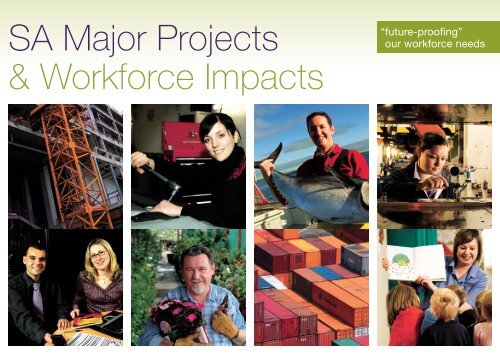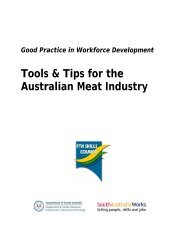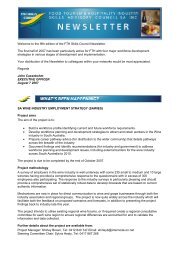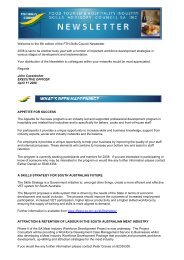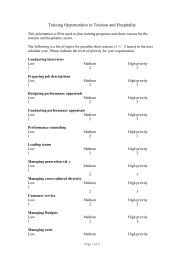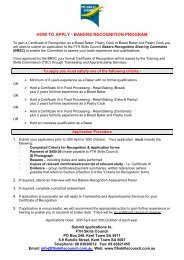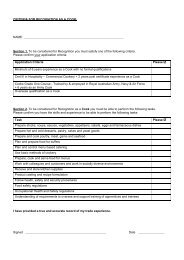SA Major Projects & Workforce Impacts - FTH Skills Council
SA Major Projects & Workforce Impacts - FTH Skills Council
SA Major Projects & Workforce Impacts - FTH Skills Council
You also want an ePaper? Increase the reach of your titles
YUMPU automatically turns print PDFs into web optimized ePapers that Google loves.
<strong>SA</strong> <strong>Major</strong> <strong>Projects</strong><br />
& <strong>Workforce</strong> <strong>Impacts</strong><br />
“future-proofing”<br />
our workforce needs<br />
<strong>SA</strong> <strong>Major</strong> <strong>Projects</strong> & <strong>Workforce</strong> <strong>Impacts</strong>
Creating Awareness<br />
In late 2006 the Industry <strong>Skills</strong> Boards in South Australia<br />
saw the need to make industry and government aware of<br />
the workforce impact of major projects, and to encourage<br />
industry and government to focus resources to solve the<br />
skills and labour shortages in a holistic manner across the<br />
industries and the state, rather than acting independently.<br />
Key major project proponents were contacted<br />
directly to discuss the employment needs of<br />
their projects. This proved extremely difficult<br />
and it was obvious that many of these industry<br />
contacts did not have a clear picture of the<br />
direct workforce and employment needs<br />
of their projects and little understanding of<br />
the indirect needs or impacts. This led to a<br />
number of recommendations for industry and<br />
government which are explained in detail in<br />
the <strong>Workforce</strong> Impact <strong>SA</strong> Report.<br />
The nine Industry <strong>Skills</strong> Boards which represent<br />
all industry sectors in <strong>SA</strong>, created a small<br />
collaborative project with the Department<br />
of Further Education Employment Science<br />
and Technology (DFEEST) and the Australian<br />
Institute of Social Research, based at Adelaide<br />
University to:<br />
• identify major projects and their workforce<br />
impacts<br />
• identify the indirect implications such as<br />
transport, power, housing infrastructure<br />
and community services<br />
• provide recommendations to facilitate a<br />
whole-of-government and appropriate<br />
industry response<br />
• develop a simple analysis and reporting<br />
format tool that can be repeated annually.<br />
Due to the significance of the recently<br />
announced major mining and defence projects,<br />
the State Government has created separate<br />
skills institutes in these areas. These are the<br />
Defence <strong>Skills</strong> Institute (which is incorporated<br />
in the Defence Teaming Centre), the Maritime<br />
<strong>Skills</strong> Centre and the Mineral Resources and<br />
Heavy Engineering <strong>Skills</strong> Centre.<br />
<strong>Major</strong> projects were identified initially, based<br />
on the 2006 <strong>Major</strong> Developments Directory<br />
produced by the Department of Trade and<br />
Economic Development. This list was added to<br />
by using the Industry <strong>Skills</strong> Boards networks,<br />
the projects known to the Construction<br />
Industry Training Board and the regional<br />
knowledge of the DFEEST Employment<br />
and <strong>Skills</strong> Formation Network, which has<br />
representatives operating in each of South<br />
Australia’s 17 regions. It became evident in<br />
this process that there are a large number<br />
of projects under consideration that will<br />
significantly add to the list in the near future,<br />
making the need for action on the workforce<br />
and skills impact of the projects even more<br />
critical.<br />
It also became obvious to the Industry <strong>Skills</strong><br />
Boards Representative Group that one of the<br />
keys to facilitating industry and government<br />
response was to create a matrix of major<br />
projects. Businesses are encouraged to<br />
consider where they fit by industry and region,<br />
and to think about and plan for the workforce<br />
(and other) impacts of major projects. The<br />
matrix will be available for industry and<br />
government. It is recommended that the<br />
matrix is updated regularly as a valuable<br />
tool for “future-proofing” South Australia’s<br />
workforce needs.<br />
Graham Oades<br />
Project Manager,<br />
<strong>SA</strong> Industry <strong>Skills</strong> Boards Joint Project<br />
<strong>SA</strong> <strong>Major</strong> <strong>Projects</strong> & <strong>Workforce</strong> <strong>Impacts</strong>
<strong>Workforce</strong> <strong>Impacts</strong><br />
of <strong>Major</strong> <strong>Projects</strong><br />
Typical <strong>Major</strong> Project Employment Creation<br />
Employment<br />
Project Employment<br />
Indirect Employment<br />
The <strong>Workforce</strong><br />
Challenge<br />
Population growth in South Australia has been well under 1% this<br />
decade – one third of the 1960s growth. Within ten years, one<br />
third of the state’s workforce will be approaching retirement. The<br />
number of people of working age will start to reduce from 2011<br />
and currently for every young person entering the workforce<br />
there are seven people over 45 years of age. Estimates suggest<br />
that between 2005-2006 and 2013-2014 there will be 338,100<br />
job openings created by retirement. (Source: Centre for Policy<br />
Studies 2005)<br />
South Australia has over 200 approved major projects across<br />
all 17 regions. The combined value of these projects is<br />
more than $30 billion. Approximately 90 of these projects<br />
($12 billion) are currently in the construction phase, some<br />
nearing completion. Added to this, there are at least twenty<br />
major projects under consideration that will shortly be<br />
approved or become public. The 200 plus major projects<br />
span all industry sectors with major concentrations in mining,<br />
defence and construction. Approximately $200 million worth<br />
of projects such as school expansions and energy projects<br />
have multiple locations across regions that do not have<br />
individual values. These projects are included in the matrix<br />
and highlighted as “multi regional”.<br />
The direct and indirect workforce (employment) and other<br />
impacts of major projects will be felt most strongly in the<br />
regional areas of South Australia that have a disproportionate<br />
value of these projects in relation to their population. The<br />
regions also have less infrastructure, housing and transport<br />
capacity to deal with the flow-on impacts of the projects.<br />
Planning Phase Construction Phase Operational Phase<br />
Time<br />
The diagram shows the impact major projects have on indirect employment.<br />
The indirect employment impacts are rarely considered or analysed, except for<br />
extremely large projects such as Olympic Dam and the Air Warfare Destroyer<br />
projects.<br />
This major projects “good news”, dominated by mining and<br />
defence, is enhanced by the prediction of strong ongoing<br />
general economic activity and the availability of investment<br />
capital. With lowering unemployment and the mass retirement<br />
of baby boomers, the focus needs to move to the impact<br />
on the available workforce and whether it has the right skills.<br />
<strong>Major</strong> projects will accelerate the workforce challenge South<br />
Australia is now facing.<br />
New indirect jobs<br />
The BHP Olympic Dam project and other major mining<br />
projects are examples of how significant the direct, indirect<br />
and workforce impacts of a major project can be. Between<br />
2006 and 2014, as many as 18,000 new indirect jobs may<br />
be created from mining projects. This figure is close to<br />
half of South Australia’s current unemployment numbers.<br />
The estimate increases to between 2500 and 3000 new<br />
jobs per year over the next eight years when the indirect<br />
impacts of the defence projects are added.<br />
The workforce solutions to this issue must involve<br />
the unemployed (approximately 40,000 people), the<br />
underemployed (those who would like to work more hours)<br />
and those discouraged jobseekers who are not participating<br />
due to a lack of the right opportunity, incentives, skills and<br />
a host of personal and societal reasons. Estimates suggest<br />
that the current total number of South Australians who could<br />
realistically be drawn into the workforce is over 100,000<br />
people. From an economic point of view, it is critical that<br />
this group is assisted into employment as openings become<br />
available. If this does not occur it is estimated that within ten<br />
years the labour demand may exceed supply by between<br />
10,000 and 12,000 people per year. Inter-industry transfer will<br />
be generated as workers move from lower paying industries,<br />
creating significant pressure on high labour cost and low<br />
margin industries. Some analysts are predicting this may<br />
restrict further economic growth from 2014 by 40%.<br />
<strong>SA</strong> <strong>Major</strong> <strong>Projects</strong> & <strong>Workforce</strong> <strong>Impacts</strong>
Current <strong>Workforce</strong> Skill Level<br />
Percentage of the <strong>Workforce</strong><br />
Yr 10 Trade Degree<br />
Future <strong>Workforce</strong> Skill Needs<br />
These graphs show the need to upskill South Australia’s workforce to meet<br />
the higher skills levels required to keep businesses globally competitive.<br />
The skills demanded across the economy are changing.<br />
There is a greater call for higher skill and qualification levels<br />
and for more specialised positions to be filled. The graphs<br />
above show how the workforce skill levels must increase<br />
to meet the demand of these projects. Businesses must<br />
be aware of the need to begin planning and changing<br />
organisational culture to minimise the impacts of the<br />
workforce challenge facing the state.<br />
Percentage of the <strong>Workforce</strong><br />
Yr 10 Trade Degree<br />
Supply and Demand<br />
Conservative estimates suggest the demand for labour<br />
(workers) in South Australia will outstrip supply within ten<br />
years. In its most simple terms this means there will not be<br />
enough people to do the work! South Australia’s ageing<br />
population is one of the key reasons for this problem.<br />
Australian Bureau of Statistics (ABS) and other government<br />
data show that <strong>SA</strong> has the oldest population of all states and<br />
is aging more rapidly than the rest of the nation. This problem<br />
is being faced in most developed nations around the world.<br />
Projected Demand and Supply of Labour in South Australia<br />
People Required 000’s<br />
900<br />
800<br />
700<br />
2007 2025<br />
2017<br />
Demand<br />
Labour “Gap”<br />
Supply<br />
Arrow indicates how major projects<br />
increase labour demand and reduce<br />
the time to demand exceeding supply<br />
The graph (based on DFEEST 2007 estimates of ABS and Monash Centre of Policy<br />
Studies data) shows how new major projects may shorten the time before demand<br />
outstrips supply.<br />
The <strong>SA</strong> <strong>Major</strong><br />
<strong>Projects</strong> Matrix<br />
The <strong>Workforce</strong> Impact <strong>SA</strong> <strong>Major</strong> <strong>Projects</strong> Matrix is a snapshot<br />
of the major projects in <strong>SA</strong> by industry sector and by region,<br />
as at April 2007.<br />
The matrix includes projects nearing completion as<br />
well as those approved, but not yet commenced. Each<br />
project is listed with their dollar value in millions, with an<br />
indication of whether it is likely to have a major impact in<br />
the areas of employment, skills and training, construction,<br />
accommodation and housing, transport, infrastructure, health<br />
and community services, and power. The impact of a project<br />
can be much greater in a regional area where services and<br />
infrastructure are constrained.<br />
Industry and businesses can use the matrix to consider the<br />
impact of major projects from a positive (business generating)<br />
point of view and also from a risk management perspective.<br />
The matrix provides policy makers and government agencies<br />
with an overview to best focus regional resources, and<br />
enables training and education providers to pinpoint projects<br />
and regions where skills and employment are going to be<br />
in the greatest demand. The population and employment<br />
figures included by region also give a good understanding of<br />
some of the labour supply issues. Comparing the variation<br />
in unemployment from 2.2% on Kangaroo Island to 8.3%<br />
in Northern Adelaide (with 50 times the population) is<br />
enlightening when considering labour pools for projects.<br />
It is also hoped the matrix will be used as an educational tool<br />
in schools, in further education and by universities as well as<br />
a tool for job hunters, consultants and contractors who may<br />
target a project or region.<br />
During this project the Industry <strong>Skills</strong> Boards became aware<br />
of at least 20 projects under consideration that will shortly be<br />
approved or become public. It is likely that local councils and<br />
regional businesses have access to information regarding<br />
other major projects which may need to be included.<br />
<strong>SA</strong> <strong>Major</strong> <strong>Projects</strong> & <strong>Workforce</strong> <strong>Impacts</strong>
The matrix also does not show the impact of regulatory<br />
decisions such as the recent changes to crowd control (security)<br />
licensing that has created a labour shortage of many hundreds<br />
of licensed security workers across the state. It also does not<br />
include redundancies or rationalisations. These issues need to<br />
be considered in addition to the impacts shown on the matrix.<br />
Prompting <strong>Workforce</strong> Planning<br />
The current <strong>SA</strong> workforce challenge is not going to be<br />
solved solely by government policy. It will require action<br />
by businesses to protect themselves and adapt to the<br />
changing workforce environment. For those businesses<br />
in high labour cost, low wage rate and mature workforce<br />
environments the challenge will be the most critical.<br />
The key message that businesses should take from the <strong>SA</strong><br />
<strong>Major</strong> <strong>Projects</strong> Matrix and <strong>Workforce</strong> Impact <strong>SA</strong> Report<br />
is the urgent need to understand the risks of impending<br />
skills and labour shortages and how to deal with them.<br />
Businesses need to take this opportunity to assess the<br />
need to change their workforce management practices.<br />
This will be key to attracting and retaining staff.<br />
The Talent War<br />
It’s clear there is already a “war for talent” in <strong>SA</strong> in key<br />
skills areas. This “war” will eventually become a battle for<br />
labour across the whole Australian economy. Recruiting and<br />
retention in lower paid employment will become extremely<br />
difficult as employers compete for labour. The employment<br />
demands of major projects will exacerbate this. Shortages<br />
in skilled jobs relating to mining, defence and construction<br />
are already evident and, in some cases, are causing wage<br />
increases in the region of 10% pa. At a recent CEDA<br />
conference, a BHP spokesman commented that the eventual<br />
labour cost of the Olympic Dam project (in billions) would be<br />
influenced by the salaries being paid in the mining industry<br />
in Western Australia, which is an alternative and benchmark<br />
for potential employees and contractors in <strong>SA</strong>. Regional<br />
shortages will be the most extreme, as existing businesses<br />
see mass staff movement to high paying projects.<br />
Possible 5% Wage Inflation Impact on Profits<br />
100<br />
Profit 12%<br />
Loss 2%<br />
% Profit<br />
% Loss<br />
% of Business Turnover<br />
50<br />
0<br />
Payroll 50%<br />
Other Costs 38%<br />
Payroll 64%<br />
Other Costs 38%<br />
Now Possible 2012<br />
% Payroll<br />
% Other<br />
This graph illustrates that over a 5-year period of labour<br />
shortage-generated wage inflation (5% net increase<br />
compounding), a company with high payroll costs could<br />
have its profit wiped out. This is a possible scenario in<br />
South Australia within the next ten years if businesses and<br />
industry sectors do not plan to deal with the likely labour<br />
shortage issues. Competitive industries with high labour costs<br />
and low wages will be the most vulnerable. It may lead to<br />
rationalisation in many industry sectors, especially those with<br />
a large ‘small business’ base. Many companies may have to<br />
review their business models.<br />
Impact on Your Business<br />
Current Australian Institute of Management figures suggest<br />
replacing a person costs $20,000 and average small business<br />
labour turnover is now 18% per annum. There are critical<br />
workforce planning and business questions <strong>SA</strong> companies<br />
should be asking such as:<br />
• What is my annual labour turnover? (number of workers<br />
who have left in the last year divided by the total number of<br />
normal workers multiplied by 100) Has it been increasing?<br />
What is this labour turnover costing my business?<br />
• What will the labour requirements of my business be<br />
in five years? Can my current workforce meet these<br />
requirements? Will they have the skills? Do I have a plan<br />
for meeting the workforce needs?<br />
<strong>SA</strong> <strong>Major</strong> <strong>Projects</strong> & <strong>Workforce</strong> <strong>Impacts</strong>
• Are the pay rates and working conditions competitive with<br />
other industries? How does my business and industry<br />
compare to my competitors and other industries for pay<br />
and conditions? Will major projects in my region have an<br />
impact? Will this impact be positive or negative?<br />
• How many of my employees are likely to retire in the next<br />
five years? What can I do to prevent potential retirees from<br />
leaving?<br />
• Have I considered what to do if key staff leave? Do I have<br />
a succession plan? Do I have the training in place in case I<br />
lose a key staff member? Am I willing to look at wider pool<br />
of labour such as mature aged, the underemployed (job<br />
sharing etc), indigenous and migrant groups?<br />
• Do I and the other managers have the skills and<br />
knowledge to be able to get the best of my staff? Do I<br />
provide enough leadership? Are the roles of my workers<br />
clear? Have we undertaken a skills and training audit of the<br />
current business requirements? Can we extrapolate this to<br />
the next five years and recruit and train for the likely gaps?<br />
• Do we understand the cultural and lifestyle expectations<br />
of our workers? Can we offer better work/life balance,<br />
flexibility, recognition, security, promotion opportunities and<br />
personal challenges within the constraints of the business?<br />
The Need for <strong>Workforce</strong><br />
Impact Assessments<br />
The graph below clearly indicates that South Australia faces<br />
the biggest workforce challenge in Australia. The “Forecast<br />
Reduction in Average Annual Employment Growth (% of<br />
baseline employment growth rate) due to population ageing,<br />
by State and Territory, 2004-05 to 2009-10” predicts that<br />
employment growth in <strong>SA</strong> will be restricted by 40% due to<br />
aging-related labour shortages and pressure.<br />
Forecast reduction in average annual employment growth<br />
(% of baseline employment growth rate) due to population ageing,<br />
by State and Territory, 2004-05 to 2009-10<br />
<strong>SA</strong><br />
ACT<br />
TAS<br />
VIC<br />
NSW<br />
AUS<br />
QLD<br />
WA<br />
NT<br />
17.4<br />
17.1<br />
20.3<br />
0 10 20 30 40 50<br />
This is why careful consideration of the workforce needs and<br />
impacts of a major project are more critical now than they<br />
have ever been before. Most major projects are required to<br />
carry out Environmental Impact Assessments, but only a<br />
small portion of major of projects are carrying out a detailed<br />
public or private workforce impact assessment. During the<br />
<strong>Workforce</strong> Impact <strong>SA</strong> project, when major project proponents<br />
were contacted, most of them did not know the likely<br />
direct employment outcomes of the project and had little<br />
understanding of the indirect impacts.<br />
24.7<br />
26.5<br />
27.4<br />
34.7<br />
36.1<br />
Percent of baseline employment growth rate<br />
Source: Centre of Policy Studies, MONASH model forecasts<br />
42.9<br />
A workforce impact assessment for each major project<br />
should be based on a consistent template that is demanddriven.<br />
This information will help build up a knowledge base<br />
to make indirect impact modeling more accurate in the future<br />
A suggested template would include:<br />
<strong>Major</strong> Project <strong>Workforce</strong> Impact Assessment Template<br />
Information provided by<br />
the project proponent<br />
Company Details<br />
– key company contacts<br />
Project Details<br />
Location, industry, $m value,<br />
planning, construction&<br />
operational timelines<br />
<strong>Workforce</strong> Requirements<br />
Direct company employment<br />
during each project phase<br />
Breakdown of qualification<br />
levels of employment<br />
Breakdown of employment<br />
duration<br />
Indirect Project <strong>Impacts</strong><br />
Project requirements for<br />
transport, accommodation,<br />
power,<br />
infrastructure, training,<br />
key resources & suppliers etc<br />
Competitive <strong>Impacts</strong><br />
Known positive or negative<br />
impacts on competitor or<br />
industry employment<br />
Government input &<br />
assistance that may apply<br />
Government<br />
contact officer(s)<br />
Project is added to the<br />
<strong>Major</strong> <strong>Projects</strong> Directory<br />
database<br />
Industry sector skills<br />
replacement analysis is<br />
undertaken<br />
Define what government<br />
assistance may be provided<br />
Provide links to relevant ISB,<br />
ESF network(s)<br />
Assess the need for/arrange<br />
impact modelling<br />
Link to relevant departments<br />
to clarify requirements and<br />
impact<br />
Provide general economic<br />
growth analysis<br />
<strong>SA</strong> <strong>Major</strong> <strong>Projects</strong> & <strong>Workforce</strong> <strong>Impacts</strong>
The workforce impact assessment will act as an early warning<br />
for the business and for government regarding the project. It<br />
should allow the application of known workforce solutions to<br />
problems generated by the project. The level of government<br />
input would depend on the nature and scale of the project<br />
and its region.<br />
Recommendations<br />
The <strong>Workforce</strong> Impact <strong>SA</strong> Report has made a number of<br />
important recommendations suggesting options for the<br />
future to allow the proper assessment of the impact of major<br />
projects on employment, skills, infrastructure, housing etc.<br />
These are that:<br />
1. The major projects matrix is widely distributed each year<br />
and updated on a website every three months. This could<br />
be in the form of an online tool associated with the current<br />
<strong>Major</strong> <strong>Projects</strong> Database.<br />
2. A workforce impact assessment template is agreed by this<br />
project’s stakeholders. This will create a consistent base<br />
for analysis of projects and provide an aid to businesses<br />
undertaking major projects.<br />
3. All significant major projects go through a workforce<br />
impact assessment process with the assistance of the<br />
appropriate <strong>SA</strong> government or Industry <strong>Skills</strong> Board<br />
representatives.<br />
4. The South Australian Government adopt a consistent<br />
model (Such as the RISE model) to analyse the indirect<br />
employment impacts of major projects.<br />
5. The South Australian Government commission a<br />
comprehensive industry workforce consultation every two<br />
years to identify and plan for critical employment and skills<br />
needs.<br />
6. Other indirect impacts of major projects (in addition to<br />
workforce impacts) are also accurately assessed by<br />
government and this information is made public. This<br />
information could also form part of the online tool in<br />
Recommendation 1.<br />
Issues and Comments<br />
A number of issues arose from discussions during the<br />
<strong>Workforce</strong> Impact <strong>SA</strong> project that can form the basis of<br />
further thinking and planning. These include:<br />
1. Information gathered from major project employment and<br />
skills demand, via the major projects database and the<br />
analysis of the projects, must be linked to labour supply<br />
information regionally, with the assessment of available<br />
labour by skills and qualifications. This should drive<br />
resource and funding allocation to resolve regional skills<br />
shortages in a more analytical manner.<br />
2. Local councils should be involved in the workforce<br />
planning process and be aware of the major projects<br />
database and its implications. They have a significant input<br />
in early warning for major projects.<br />
3. TAFE<strong>SA</strong>, schools, universities, business associations and<br />
training organisations are provided with access to the<br />
major projects matrix to aid their workforce planning and to<br />
help with educational and career activities.<br />
4. To help businesses understand and engage in more effective<br />
workforce planning a simple resource explaining how to do a<br />
workforce impact analysis should be created, marketed and<br />
provided to businesses and other stakeholders.<br />
5. Further work is undertaken to gather data from Western<br />
Australia where the impact of skills and labour shortages<br />
is several years in advance of South Australia. This will<br />
provide valuable information on the likely impacts and<br />
methodologies for dealing with them.<br />
6. A list on non-project related impacts is kept as part of an<br />
adjunct to the matrix. This would include major changes<br />
to laws, regulations etc that will have workforce impacts<br />
similar to major projects.<br />
Note: These recommendations do not imply agreement by the South Australian<br />
Government, or any stakeholder, to proceed with work.<br />
<strong>SA</strong> <strong>Major</strong> <strong>Projects</strong> & <strong>Workforce</strong> <strong>Impacts</strong>
Going Forward<br />
The Industry <strong>Skills</strong> Boards will be progressing the workforce<br />
planning message relating to major projects and also as a<br />
necessary management skill for all businesses. The work<br />
to continue the momentum and awareness created by this<br />
project will involve:<br />
1. Marketing and distribution of the report and matrix via<br />
forums, the Industry <strong>Skills</strong> Board network and through the<br />
regional Employment and <strong>Skills</strong> Formation Network. This<br />
should provide coverage of close to 10,000 organisations.<br />
2. Seeking the publication of the matrix and editorial in state<br />
and local newspapers to increase public understanding<br />
and awareness of the need to continue addressing the<br />
state’s workforce challenge.<br />
3. Inviting key project stakeholders to a roundtable to<br />
collaboratively progress the recommendations of the<br />
report and ensure the creation and distribution of the tools<br />
proposed by the project.<br />
4. Integrating the outcomes of this project into a number of<br />
workforce planning and development projects currently in<br />
the pipeline including several major collaborative projects<br />
focused on major project impacts.<br />
5. Continuing to consult with key business stakeholders in each<br />
industry sector to provide expertise and tools to support and<br />
assist with workforce development and planning.<br />
<strong>Workforce</strong><br />
Development Links<br />
Industry <strong>Skills</strong> Board<br />
Industry <strong>Skills</strong> Boards are a facilitator between industry and<br />
government on skills issues incorporating strategic industry<br />
workforce planning, training and development, particularly<br />
in vocational education and are base funded by the South<br />
Australian Government.<br />
Service <strong>Skills</strong> <strong>SA</strong>: www.serviceskillssa.com.au<br />
Food, Tourism and Hospitality <strong>Skills</strong> <strong>Council</strong>:<br />
www.fthskillscouncil.com.au<br />
<strong>SA</strong> Health and Community Services <strong>Skills</strong> Board:<br />
www.sahcssb.com.au<br />
Manufacturing <strong>Skills</strong> Board: www.misac.com.au<br />
Business Services Industry <strong>Skills</strong> Board South Australia<br />
Inc: www.bsisb.com.au<br />
Construction Industry Training Board:<br />
www.constructionskills.com.au<br />
Electrical, Electro technology, Energy<br />
and Water <strong>Skills</strong> Board: www.eeewsb.com.au<br />
Primary Industries <strong>Skills</strong> <strong>Council</strong>: www.pisc.org.au<br />
Transport Industry <strong>Skills</strong> Board: www.tdtsa.com.au<br />
In addition to the nine Industry <strong>Skills</strong> Boards, the following<br />
organisations assisted with project information for the <strong>Major</strong><br />
<strong>Projects</strong> Matrix 2007:<br />
South Australian Chamber of Mines and Energy:<br />
www.resourcessa.org.au<br />
Defence Teaming Centre: www.dtc.org.au<br />
ESF Network<br />
Employment and Skill Formation Networks are collaborative<br />
local partnerships between regional development boards,<br />
industry, community organisations, training organisations and<br />
all levels of government. They work to meet the workforce<br />
development, training and employment needs of local<br />
businesses and jobseekers.<br />
For information regarding your local Employment and Skill<br />
Formation Network please refer to the contact details at the<br />
bottom of the <strong>Major</strong> <strong>Projects</strong> Matrix for your local region.<br />
For further information follow the regional links on the South<br />
Australian Works website: www.saworks.sa.gov.au/pages/<br />
saworks/regions<br />
Department of Further Education,<br />
Employment, Science and Technology<br />
Refer to www.dfeest.sa.gov.au<br />
The <strong>Workforce</strong> Development Directorate of DFEEST is the<br />
key government stakeholder in this project. The <strong>Workforce</strong><br />
Information Service (WIS) also assisted with this project.<br />
www.workforceinfoservice.sa.gov.au<br />
This project was part funded through the <strong>SA</strong> Works<br />
<strong>Workforce</strong> Development Fund.<br />
Other Key Links<br />
Other key links that have been vital for the <strong>Major</strong> <strong>Projects</strong><br />
Matrix 2007 to be developed are:<br />
The Australian Institute for Social Research:<br />
www.aisr.adelaide.edu.au<br />
The South Australian Centre for Economic Studies:<br />
www.adelaide.edu.au/saces<br />
South Australian Works:<br />
www.saworks.sa.gov.au/pages/saworks/regions<br />
Department of Trade and Economic Development:<br />
www.southaustralia.biz/dted/index.htm<br />
South Australia Biz: www.southaustralia.biz<br />
Department of Trade and Economic Development<br />
<strong>Major</strong> <strong>Projects</strong>: www.majorprojects.sa.gov.au<br />
Department of Employment and Workplace Relations:<br />
www.dewr.gov.au<br />
Department of Employment and Workplace Relations<br />
<strong>Skills</strong> Information: www.skillsinfo.gov.au/skills/regions/sa<br />
<strong>Skills</strong> in Demand: www.workplace.gov.au/NR/rdonlyres/<br />
35D58940-96FF-4260-AB85-23D9BF7CAF64/0/<br />
<strong>Skills</strong>inDemandSeptember2006.pdf<br />
South Australian Strategic Plan Website:<br />
www.stateplan.sa.gov.au/<br />
<strong>SA</strong> <strong>Major</strong> <strong>Projects</strong> & <strong>Workforce</strong> <strong>Impacts</strong>


